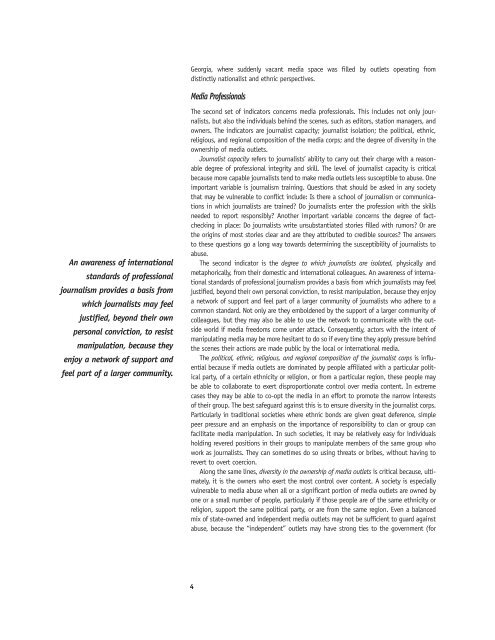Institutional Racism
Institutional Racism
Institutional Racism
Create successful ePaper yourself
Turn your PDF publications into a flip-book with our unique Google optimized e-Paper software.
Georgia, where suddenly vacant media space was filled by outlets operating from<br />
distinctly nationalist and ethnic perspectives.<br />
Media Professionals<br />
An awareness of international<br />
standards of professional<br />
journalism provides a basis from<br />
which journalists may feel<br />
justified, beyond their own<br />
personal conviction, to resist<br />
manipulation, because they<br />
enjoy a network of support and<br />
feel part of a larger community.<br />
The second set of indicators concerns media professionals. This includes not only journalists,<br />
but also the individuals behind the scenes, such as editors, station managers, and<br />
owners. The indicators are journalist capacity; journalist isolation; the political, ethnic,<br />
religious, and regional composition of the media corps; and the degree of diversity in the<br />
ownership of media outlets.<br />
Journalist capacity refers to journalists’ ability to carry out their charge with a reasonable<br />
degree of professional integrity and skill. The level of journalist capacity is critical<br />
because more capable journalists tend to make media outlets less susceptible to abuse. One<br />
important variable is journalism training. Questions that should be asked in any society<br />
that may be vulnerable to conflict include: Is there a school of journalism or communications<br />
in which journalists are trained? Do journalists enter the profession with the skills<br />
needed to report responsibly? Another important variable concerns the degree of factchecking<br />
in place: Do journalists write unsubstantiated stories filled with rumors? Or are<br />
the origins of most stories clear and are they attributed to credible sources? The answers<br />
to these questions go a long way towards determining the susceptibility of journalists to<br />
abuse.<br />
The second indicator is the degree to which journalists are isolated, physically and<br />
metaphorically, from their domestic and international colleagues. An awareness of international<br />
standards of professional journalism provides a basis from which journalists may feel<br />
justified, beyond their own personal conviction, to resist manipulation, because they enjoy<br />
a network of support and feel part of a larger community of journalists who adhere to a<br />
common standard. Not only are they emboldened by the support of a larger community of<br />
colleagues, but they may also be able to use the network to communicate with the outside<br />
world if media freedoms come under attack. Consequently, actors with the intent of<br />
manipulating media may be more hesitant to do so if every time they apply pressure behind<br />
the scenes their actions are made public by the local or international media.<br />
The political, ethnic, religious, and regional composition of the journalist corps is influential<br />
because if media outlets are dominated by people affiliated with a particular political<br />
party, of a certain ethnicity or religion, or from a particular region, these people may<br />
be able to collaborate to exert disproportionate control over media content. In extreme<br />
cases they may be able to co-opt the media in an effort to promote the narrow interests<br />
of their group. The best safeguard against this is to ensure diversity in the journalist corps.<br />
Particularly in traditional societies where ethnic bonds are given great deference, simple<br />
peer pressure and an emphasis on the importance of responsibility to clan or group can<br />
facilitate media manipulation. In such societies, it may be relatively easy for individuals<br />
holding revered positions in their groups to manipulate members of the same group who<br />
work as journalists. They can sometimes do so using threats or bribes, without having to<br />
revert to overt coercion.<br />
Along the same lines, diversity in the ownership of media outlets is critical because, ultimately,<br />
it is the owners who exert the most control over content. A society is especially<br />
vulnerable to media abuse when all or a significant portion of media outlets are owned by<br />
one or a small number of people, particularly if those people are of the same ethnicity or<br />
religion, support the same political party, or are from the same region. Even a balanced<br />
mix of state-owned and independent media outlets may not be sufficient to guard against<br />
abuse, because the “independent” outlets may have strong ties to the government (for<br />
4

















